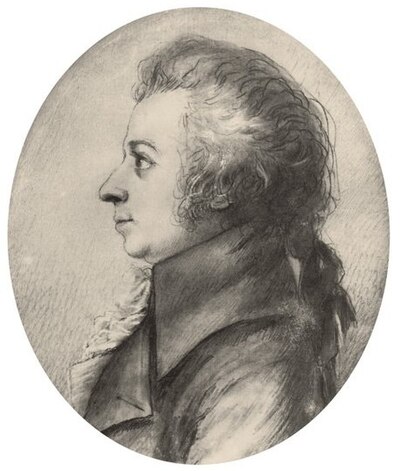This is an old revision of this page, as edited by Opus33 (talk | contribs) at 20:02, 8 December 2007 (another ref). The present address (URL) is a permanent link to this revision, which may differ significantly from the current revision.
Revision as of 20:02, 8 December 2007 by Opus33 (talk | contribs) (another ref)(diff) ← Previous revision | Latest revision (diff) | Newer revision → (diff)Doris (Dora, Dorothea) Stock (1760-1852) was an amateur artist of the 18th and 19th centuries. She is remembered for making one of the last portraits of Wolfgang Amadeus Mozart, as well as for telling a characteristic anecdote about him.
She was the daughter of a Leipzig copper engraver. Little seems to be known of her life.
Stock's Mozart portrait
On either 16 or 17 April, 1789, Stock was at the home of her brother-in-law, the Dresden consistorial councillor Christian Gottfried Körner. Mozart was passing through town and giving concerts during the Berlin journey he made during Spring 1789. Stock, a capable draftsman, took the occasion to sketch a portrait of Mozart in silverpoint on ivory board:

Apparently silverpoint was not widely practiced at the time (see silverpoint); Stock may have known the medium from having been the daughter of an engraver.
Rosenthal indicates that the portrait was kept by one Friedrich Körner (whom he does not identify) for some 50 years after it was made.
Stock's Mozart anecdote
Nineteen years after her death, Gustav Parthey published a book called Jugenderinnerungen ("Remembrances of youth", 1871). He related a tale about Mozart's visit that Doris Stock had told him during her lifetime:
- Mozart himself, during his short stay in Dresden, was an almost daily visitor to the Körners' house. For the charming and witty Doris he was all aflame and with his south Germanvivacity he paid her the naïvest compliments. He generally came shortly before dinner and, after he had poured out a stream of gallant phrases, he sat down to improvise at the pianoforte. In the next room the table was meanwhile being set and the soup dished up, and the servant announced that dinner was served. But who could tear himself away when Mozart was improvising! The soup was allowed to grow cold and the roast to burn, simply so that we could continue to listen to the magic sound which the master, completely absorbed in what he was doing and unaware of the rest of the world, conjured from the instrument. Yet one finally grows tired even of the highest pleasures when the stomach makes known its demands. After the soup had grown cold a few times while Mozart played, he was briefly taken to task. "Mozart", said Doris, gently laying her snow-white arm on his shoulder, "Mozart, we are going in to dine; do you want to eat with us?" But it was precisely Mozart who never did come; he played on undisturbed. Thus we often had the rarest Mozartian musical accompaniment to our meal, Doris concluded her narrative, and when we rose from table we found him still sitting at the keyboard.
Deutsch (reference below) notes that the anecdote probably exaggerates the number of times that Mozart visited the Körner home. The house was on the street in Dresden now called the Körnergasse.
Notes
- Rosenthal 1995
- Mozart was from Salzburg, now part of Austria. At the time Salzburg was a quasi-independent country, one of the hundreds of small states collectively referred to at the time as "Germany".
References
Except as indicate by footnote all information in this article is taken from the following reference source:
- Deutsch, Otto Erich (1965) Mozart: A Documentary Biography. Stanford, CA: Stanford University Press.
The discussion of Stock's portrait appears on p. 340, the dinner anecdote on pp. 568-569.
Other references consulted:
- Rosenthal, Albi (1995) "Laughing Stock," letter to the editor, The Musical Times, Vol. 136, No. 1833, (November), p. 572. Available on JSTOR.